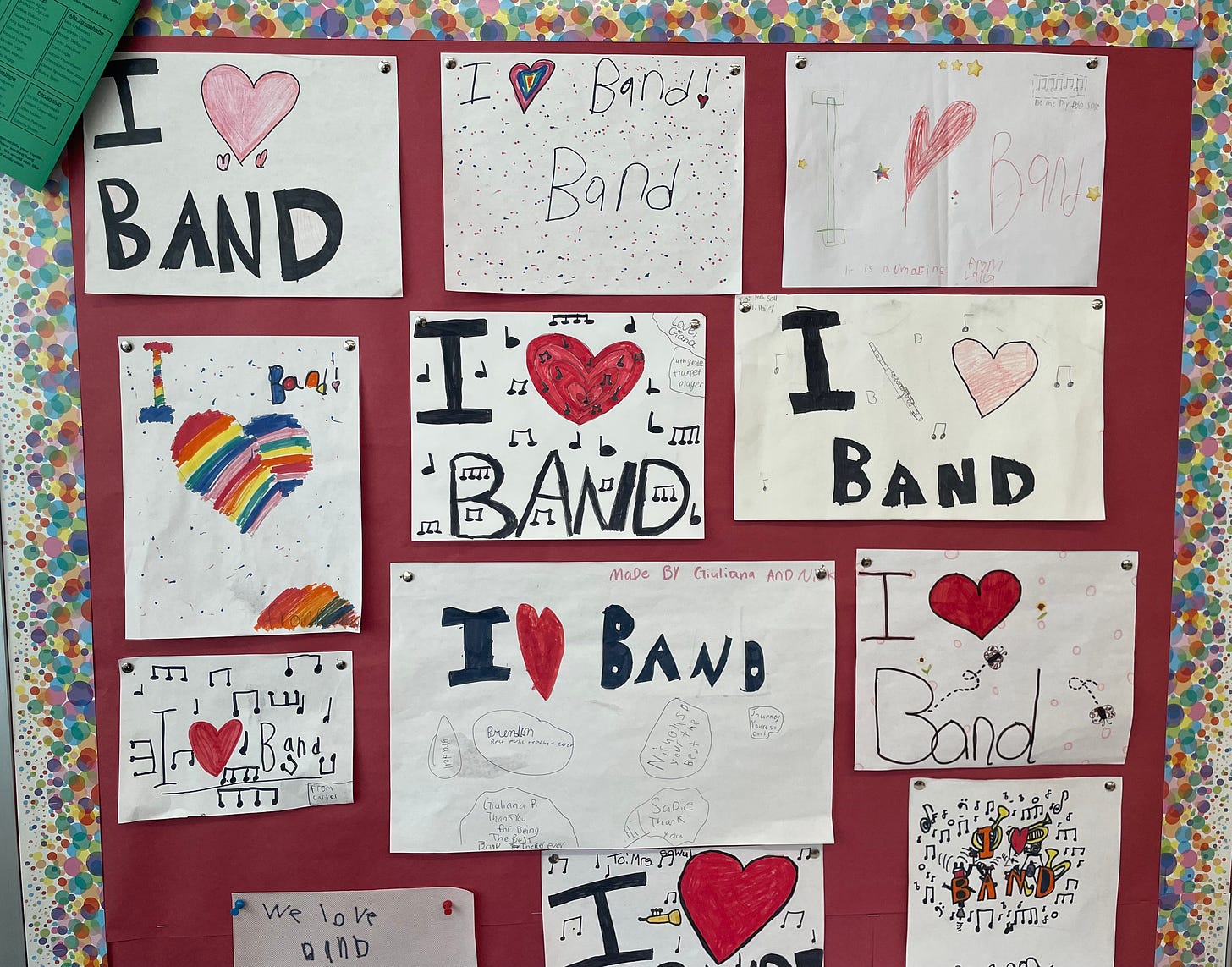The Story
Last week, I wrote about how marching band— really, my entire school band program— saved me. It taught me that I didn’t have to walk through my cancer experience alone; even if I never shared a word of it with my bandmates, the community experience of music, movement and togetherness made me feel uplifted, supported, healed.
It is perhaps unsurprising that I became a band teacher, or that I’m so passionate about my job.
These are posters made by my students. They cover the walls of both my classrooms (I teach at two schools). Most kids also write me messages at the end of the school year, telling me how much they valued their band experience. They’re only nine and ten years old, but they’ve already figured out what I didn’t understand until that moment in the MRI machine.
Still, my students’ sense of community didn’t just happen; we had to build it. To some extent, they feel this way because of the ways I’ve intentionally designed the learning environment. Here are just a few of the things I do to create community:
I call them “band kids.” (Naming the community.)
I tell them, from day one, how much I love band— not just the instruments or the kids themselves, but the band rehearsal and concert experience. (Modeling the community.)
I create fun challenges throughout the year, like the practicing challenge I set up this month, called “Bandyland” (after the board game “Candyland”). Kids won prizes for achieving specific practice goals on the game board. (Rewarding the community buy-in.)
I reach out to parents and families regularly, encouraging kids to play their instruments at home, and making myself available for questions and concerns. (Strengthening community ties.)
I take every opportunity to have my students perform at school, so that younger kids can see how far they’ve come and how passionate they are. (Recruiting new members.)
At this point, I’ve been teaching band in the same schools for long enough that this community culture has become inherent. Kids know that when they join band, they get more than just learning an instrument, and it leads to siblings, neighbors and friends enthusiastically signing up when it’s their turn.
It’s been a long process, but I’m finally creating, on a continual basis, the feeling that my high school band gave to me. And I hope that every kid in my band finds an element of connection and healing, especially the ones (like me) who can’t quite express things in words.
The Character Trait
Last week, we talked about why it’s so important to be a community MEMBER. This week, we’re talking about being a community ORGANIZER. If this isn’t something you’re seeking at this point in your life— by all means, skip it! But if you feel like you’re searching for something that doesn’t yet exist, maybe you can be the one to bring it into being. Without organizers, we wouldn’t have book groups, social justice movements, or community theater. You don’t have to start from scratch— I built community within the parameters of my job!
Let’s Do Some Stuff Together
Try building community with the WHY/WHAT/HOW process:
First, decide what you want to build the community around— a hobby, a shared experience, or even an extended family— and make sure you have a clear reason for that choice (WHY).
Next, choose a method for bringing the community together, including timing, place (even if it’s on Zoom) and methods of communication (WHAT).
Then reach out for help. Once you can articulate the general parameters, get others on board, and make a list of steps toward your first gathering (HOW).
A tip: If you tend to be ambitious, propose the smallest possible iteration of what you ultimately want. For example, when I wanted to form my writing group, I thought meeting every week would be great— so I proposed once a month. It didn’t feel like enough at the time, but now, I’m so grateful I didn’t ask for more. It allowed my writing group to make a true commitment, and we’ve accomplished more with a sustainable schedule.
How did this work for you? Leave a comment below, and you might be featured in next week’s newsletter!
Stuff You Might Like To Know
I’m currently reading Dear Sister, the memoir written by Michelle Horton, sister of Nikki Addimando, a local woman who was incarcerated for killing her abuser. I’m learning so much about my community that I didn’t know… and although I wish I didn’t have to know it, I’m grateful to have my eyes opened.
I’m watching House Hunters and Chopped. My old standbys!
I’m listening to Megan Trainor’s “Made You Look” and “Me Too.” Such confidence-boosting anthems!
I will be taking a few weeks off from the newsletter to focus on my spring writing goals. I’ll be back the third or fourth week of April.
Here’s to us, in all of our imperfect, striving goodness.
Keep hoping. Keep caring. Keep trying.



I never asked but I assume high school, right? My granddaughters are in their HS band and are doing well. Love the sense of team and camaraderie it fosters. Never got to tell you how much I liked your last post about the MRI. It reminded me of the prisoners who survived horrendous conditions by playing music in their heads, directing, conducting orchestras. Thanks for such a great story, Trish